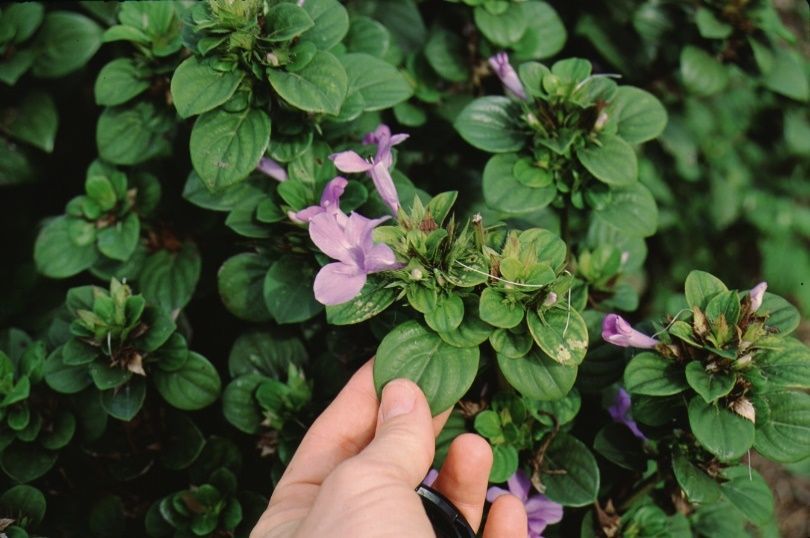Introduction
The crested Philippine violet is an herbaceous perennial that attains a height of 36 to 48 inches. Leaf tissue is puckered around the veins which appear recessed. The plant remains dense in the full sun creating a nice barrier planting. The dark green foliage is medium in texture and becomes hard and “prickly” after freezing weather. White or lavender flowers appear on this plant in the late summer and early fall.

Credit: undefined

Credit: undefined

Credit: Edward F. Gilman
General Information
Scientific name: Barleria cristata
Pronunciation: bar-LEER-ee-uh kriss-STAY-tuh
Common name(s): crested Philippine violet, Philippine violet, bluebell barleria, barleria
Family: Acanthaceae
Plant type: perennial; herbaceous
USDA hardiness zones: 9 through 11 (Figure 4)
Planting month for zone 9: year round
Planting month for zone 10 and 11: year round
Origin: native to temperate Asia and tropical Asia
Invasive potential: not considered a problem species at this time and may be recommended by UF/IFAS faculty (reassess in 10 years)
Uses: superior hedge; foundation; border
Availability: somewhat available, may have to go out of the region to find the plant

Credit: undefined
Description
Height: 4 to 6 feet
Spread: 3 to 4 feet
Plant habit: upright
Plant density: dense
Growth rate: fast
Texture: medium
Foliage
Leaf arrangement: alternate
Leaf type: simple
Leaf margin: entire
Leaf shape: ovate
Leaf venation: bowed; pinnate
Leaf type and persistence: evergreen
Leaf blade length: less than 2 inches
Leaf color: green
Fall color: no fall color change
Fall characteristic: not showy
Flower
Flower color: pink; white
Flower characteristic: summer flowering; fall flowering
Fruit
Fruit shape: no fruit
Fruit length: no fruit
Fruit cover: no fruit
Fruit color: not applicable
Fruit characteristic: inconspicuous and not showy
Trunk and Branches
Trunk/bark/branches: not particularly showy; typically multi-trunked or clumping stems
Current year stem/twig color: green
Current year stem/twig thickness: thin
Culture
Light requirement: plant grows in part shade/part sun
Soil tolerances: acidic; slightly alkaline; sand; loam; clay;
Drought tolerance: moderate
Soil salt tolerances: poor
Plant spacing: 36 to 60 inches
Other
Roots: not applicable
Winter interest: no special winter interest
Outstanding plant: plant has outstanding ornamental features and could be planted more
Pest resistance: long-term health usually not affected by pests
Use and Management
The crested Philippine violet is a good background or specimen plant but also looks nice when massed. It can be used for a hedge or border planting to create a wall effect in a garden or landscape. It will stay small enough for use along a house foundation provided they are not placed in front of a low window. Plants in the northern part of its range will be killed to the ground in freezing temperatures. Cut them back to clean the plant of dead foliage and stems. New growth emerges in the spring from the base of the stems.
Place Barleria cristata in an area of the landscape that receives full sun or partial shade. This plant prefers well-drained soils and is drought tolerant. Prune the crested Philippine violet to the ground each spring to maintain a bushy plant. Wear gloves when cleaning up this plant in the spring; the leaves become coarse after freezing and could irritate exposed skin.
Barleria cristata is "weedy" and will readily reseed itself and can invade adjacent land. Seeds and cuttings may be used for its propagation.
Pests and Diseases
None of major concern.